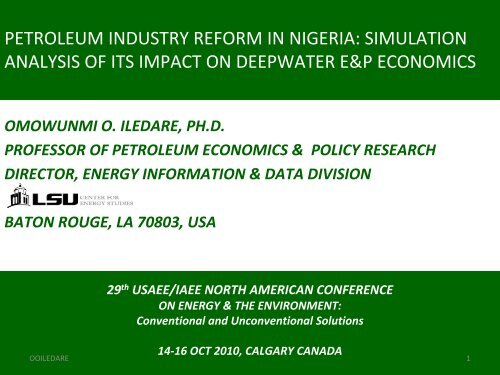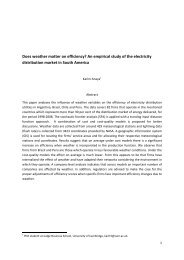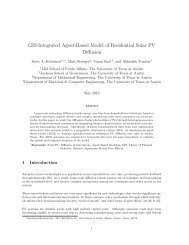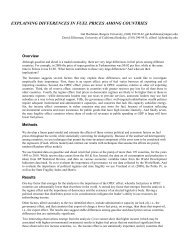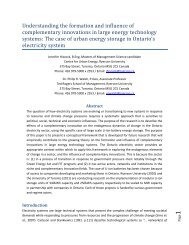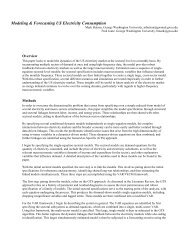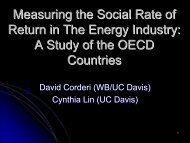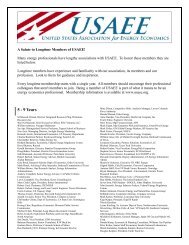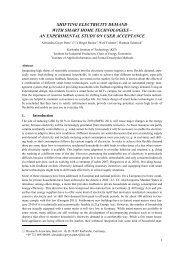PETROLEUM INDUSTRY REFORM IN NIGERIA: SIMULATION ...
PETROLEUM INDUSTRY REFORM IN NIGERIA: SIMULATION ...
PETROLEUM INDUSTRY REFORM IN NIGERIA: SIMULATION ...
Create successful ePaper yourself
Turn your PDF publications into a flip-book with our unique Google optimized e-Paper software.
<strong>PETROLEUM</strong> <strong><strong>IN</strong>DUSTRY</strong> <strong>REFORM</strong> <strong>IN</strong> <strong>NIGERIA</strong>: <strong>SIMULATION</strong><br />
ANALYSIS OF ITS IMPACT ON DEEPWATER E&P ECONOMICS<br />
OMOWUNMI O. ILEDARE, PH.D.<br />
PROFESSOR OF <strong>PETROLEUM</strong> ECONOMICS & POLICY RESEARCH<br />
DIRECTOR, ENERGY <strong>IN</strong>FORMATION & DATA DIVISION<br />
BATON ROUGE, LA 70803, USA<br />
29 th USAEE/IAEE NORTH AMERICAN CONFERENCE<br />
ON ENERGY & THE ENVIRONMENT:<br />
Conventional and Unconventional Solutions<br />
14‐16 OCT 2010, CALGARY CANADA<br />
OOILEDARE 1
Presentation Outline<br />
• Nigeria’s petroleum economy overview<br />
• Nigeria petroleum industry reform objectives<br />
• Fiscal & non fiscal reform legislative instruments<br />
• Diagnosis of fiscal legislative instruments<br />
• Impact deepwater project economics<br />
• Concluding remarks and questions<br />
OOILEDARE 2<br />
OOILEDARE<br />
USAEE 2010, Calgary, Canada
Petroleum Industry in Nigeria<br />
• Nigeria ranks among the top 10 nations in proved oil and<br />
natural gas reserves worldwide.<br />
• The largest oil producer in Africa; 7 th in OPEC; but fifth largest<br />
economy in OPEC.<br />
• As of January 1, 2010, the estimated crude oil and natural gas<br />
reserves are 37.2 billion barrels and 185.4 trillion cubic feet<br />
(TCF).<br />
– The target to expand its proven oil reserves to 40.0 billion barrels and<br />
increase its production capacity to 4 million barrels per day by 2010 is<br />
impracticable with less than three months to go.<br />
OOILEDARE 3<br />
OOILEDARE<br />
USAEE 2010, Calgary, Canada
Reform Legislation in Nigeria<br />
‣Describes the legislative, tax, contractual and fiscal<br />
elements under which petroleum operations are conducted<br />
in a petroleum province, region on nation.<br />
‣Defines the relationship between federal government of<br />
Nigeria and the oil and gas companies (IOC, NOC, & DOC).<br />
‣Explains how costs are to be recovered and profits are to<br />
be shared between firms, the host governments, and the<br />
host communities<br />
OOILEDARE<br />
USAEE 2010, Calgary, Canada<br />
4
Broad Objectives of the Reform<br />
• Provides petroleum industry operational strategies and guidelines.<br />
• Proffers solutions to petroleum fiscal problems and community<br />
issues affecting oil and gas operations in the upstream, midstream,<br />
and downstream sectors of the Nigerian petroleum economy.<br />
• Aligns the oil and gas industry in Nigeria with international best<br />
practices in order to facilitate good governance and transparency in<br />
the industry.<br />
• Assigns separate functional responsibilities to institutional<br />
structures in order to manage the commercial and operational<br />
aspects of the oil and gas sector as well as the policy‐making and<br />
regulatory aspects effectively.<br />
OOILEDARE 5<br />
OOILEDARE<br />
USAEE 2010, Calgary, Canada
Broad Objectives of the Ongoing Reform<br />
• Revamps the petroleum revenue system in terms of revenue<br />
collection, revenue enhancement, and wealth creation and<br />
restructures the taxation system for the oil and gas industry in<br />
Nigeria.<br />
• Repositions the national oil company to a level comparable to<br />
the status of other prominent national oil corporations (NOCs)<br />
• Defines a new joint venture structure to address the funding<br />
problems of industry projects with a new indsutry structure<br />
termed incorporated joint ventures (IJV).<br />
OOILEDARE 6<br />
OOILEDARE<br />
USAEE 2010, Calgary, Canada
Fiscal System Instruments<br />
Nigeria Sliding Royalty Scales<br />
Royalty B4 Reform Legislation<br />
Water Depth 0‐100 100‐200 201‐500 501‐800 801‐1000m >1000m<br />
Onshore: 20%<br />
Swamp/<br />
Shallow water<br />
18.5%<br />
Shelf PSC 16.67%<br />
Deep Offshore PSC 12% 8% 4% 0<br />
OOILEDARE<br />
USAEE 2010, Calgary, Canada<br />
7<br />
7
Fiscal Instruments for Deepwater PSC:<br />
Nigeria Taxation Examples<br />
Pre‐Reform for 1000m Water Depth<br />
OOILEDARE<br />
USAEE 2010, Calgary, Canada<br />
8<br />
8
Proposed Fiscal Instruments for<br />
Nigeria Taxation Examples<br />
All Deepwater PSC in Nigeria<br />
OOILEDARE<br />
USAEE 2010, Calgary, Canada<br />
9<br />
9
Proposed Fiscal Instruments<br />
Sliding Royalty Scales by Volume in the PIB<br />
Sliding Scale Royalty by Volume<br />
OIL<br />
Natural Gas<br />
Area/Royalty<br />
5% 12.5% 25% 5% 12.5%<br />
Onshore 0‐2M b/d 2‐5Mb/d >5Mb/d 0‐100MMcf/d >100 MMcf/d<br />
Shallow Water 0‐5M b/d 5‐20Mb/d >20Mb/d 0‐200 MMcf/d >200 MMcf/d<br />
Deep Water 0‐50M b/d 50‐100Mb/d >100Mb/d 0‐500MMcf/d >500 MMcf/d<br />
OOILEDARE<br />
USAEE 2010, Calgary, Canada<br />
10 12
Proposed Example Fiscal of Instruments<br />
Nigeria<br />
Sliding Royalty Scales by Value in the PIB<br />
Sliding Royalty Scales by Value<br />
Sliding Scale Royalty by Value<br />
Oil Price<br />
Per Bbl<br />
Royalty<br />
%<br />
Gas Price<br />
per MMBtu<br />
Royalty<br />
%<br />
$0 ‐ $70 0 $0 ‐ $2 0<br />
$70 ‐ $100 0.4 per $ $2 ‐ $7 0.20/10cents<br />
$100 ‐ $140 12 + 0.2 /$ $7 ‐ $13 10 + 0.15/10cents<br />
$140 ‐ $190 20 + 0.1/$ $13 ‐ $19 19 + 0.10/10cents<br />
OOILEDARE<br />
USAEE 2010, Calgary, Canada<br />
11<br />
11
Modeling Reform Legislation Impact<br />
on Deepwater Economics—DCF Approach<br />
Where:<br />
‣NCF t = After‐tax net cash flow in year t,<br />
‣GRR t = Gross revenue in year t,<br />
‣ROY t = Total royalty paid in year t,<br />
‣CPX t = Total capital expenditures in year t,<br />
‣OPX t = Total operating expenditures in year t,<br />
‣BNS t = Bonus paid in year t,<br />
‣PO/G t = Government profit oil in year t,<br />
‣TAX t = Total taxes paid in year t,<br />
‣OTH t = Other costs or taxes paid in year t.<br />
OOILEDARE<br />
USAEE 2010, Calgary, Canada<br />
12
Modeling Deepwater Economics<br />
—DCF Modeling Output Indicators<br />
HGT:<br />
PV =<br />
=<br />
k<br />
∑<br />
t = 1<br />
(1<br />
NCF<br />
+ D<br />
)<br />
t<br />
t<br />
− 1<br />
IRR (f, F) = { D | PV ( f ,F) = 0}<br />
OOILEDARE<br />
USAEE 2010, Calgary, Canada<br />
13
Production Sharing Contract Model<br />
Stochastic Variable Assumptions<br />
Instruments<br />
Real Oil Price,<br />
2010$/Bbl<br />
OPEX, 2010$/Bbl<br />
Actual OPEX<br />
Abroad, %<br />
Actual CAPEX<br />
Abroad, %<br />
Capacity,<br />
Bbl/Day<br />
Inflation,%<br />
Distribution<br />
Assumptions<br />
Triangular<br />
(Min, Mode, Max)<br />
Triangular<br />
(Min, Mode, Max)<br />
Triangular<br />
(Min, Mode, Max)<br />
Triangular<br />
(Min, Mode, Max)<br />
Lognormal<br />
(Mode, Mean, Std)<br />
Triangular<br />
(Min, Mode, Max)<br />
Distribution<br />
Parameters<br />
60.00 75.00 90.00<br />
5.00 6.00 7.50<br />
0 50 100<br />
0 80 100<br />
40,000 50,000 500<br />
1.0 2.0 3.0<br />
OOILEDARE<br />
USAEE 2010, Calgary, Canada<br />
14
Production Sharing Contract Model<br />
Decision Variable Base Assumptions<br />
Decision Instruments<br />
Cost Recovery Limit,<br />
%<br />
Distribution<br />
Parameters<br />
Profit Oil Split/G,% 20<br />
80<br />
Eligible Foreign<br />
CAPEX, %<br />
Eligible Foreign<br />
OPEX, %<br />
Hydrocarbon Tax<br />
CITA<br />
Allowance Cap, $/Bbl<br />
80<br />
80<br />
30<br />
30<br />
Min (7, 0.3*P)<br />
P=real oil price<br />
OOILEDARE<br />
USAEE 2010, Calgary, Canada<br />
15
Standalone Deepwater Project :<br />
100 MMB Deterministic Model Results<br />
Metric Systems Measures (Nominal$)<br />
Host Govt.<br />
BIT $MM<br />
Contractor Host Govt. AIT<br />
BIT $MM $ MM<br />
Contractor<br />
AIT $MM<br />
Net Present Value @12.5% $ 751.46 $ 777.36 $ 1,065.83 $ 293.40<br />
Internal Rate of Return 40.0% 27.5%<br />
Growth Rate of Return 16.3% 14.3%<br />
Undiscounted Take Statistics 45.1% 54.9% 72.4% 27.6%<br />
Discounted Take Statistics 49.2% 50.8% 78.4% 21.6%<br />
Metric Systems Measures (Real 2010$)<br />
Host Govt.<br />
BIT $MM<br />
Contractor Host Govt. AIT<br />
BIT $MM $ MM<br />
Contractor<br />
AIT $MM<br />
Net Present Value @12.5% $ 573.94 $ 597.06 $ 815.93 $ 220.95<br />
Internal Rate of Return 37.6% 25.7%<br />
Growth Rate of Return 16.1% 14.1%<br />
Undiscounted Take Statistics 44.4% 55.6% 71.7% 28.3%<br />
Discounted Take Statistics 49.0% 51.0% 78.7% 21.3%<br />
OOILEDARE<br />
USAEE 2010, Calgary, Canada<br />
16
Incremental Deepwater Project:<br />
100 MMB Deterministic Model Results<br />
Metric Systems Measures (Nominal$)<br />
Host Govt.<br />
BIT $MM<br />
Contractor Host Govt. AIT<br />
BIT $MM $ MM<br />
Contractor<br />
AIT $MM<br />
Net Present Value @12.5% $ 722.95 $ 805.87 $ 1,014.13 $ 345.09<br />
Internal Rate of Return 44.9% 38.7%<br />
Growth Rate of Return 16.4% 14.5%<br />
Undiscounted Take Statistics 44.8% 55.2% 72.2% 27.8%<br />
Discounted Take Statistics 47.3% 52.7% 74.6% 25.4%<br />
Metric Systems Measures (Real 2010$)<br />
Host Govt.<br />
BIT $MM<br />
Contractor Host Govt. AIT<br />
BIT $MM $ MM<br />
Contractor<br />
AIT $MM<br />
Net Present Value @12.5% $ 547.20 $ 623.80 $ 768.10 $ 268.79<br />
Internal Rate of Return 42.5% 36.7%<br />
Growth Rate of Return 16.2% 14.4%<br />
Undiscounted Take Statistics 44.0% 56.0% 71.4% 28.6%<br />
Discounted Take Statistics 46.7% 53.3% 74.1% 25.9%<br />
OOILEDARE<br />
USAEE 2010, Calgary, Canada<br />
17
Sensitivity of Nominal IRR vs. HGT<br />
to Stochastic Variables‐‐Standalone<br />
OOILEDARE 18<br />
OOILEDARE<br />
USAEE 2010, Calgary, Canada
Sensitivity of Nominal IRR vs. HGT<br />
to Decision Variables‐‐Standalone<br />
OOILEDARE 19<br />
OOILEDARE<br />
USAEE 2010, Calgary, Canada
Sensitivity of Nominal IRR vs. HGT<br />
to Stochastic Variables‐‐Standalone<br />
OOILEDARE 20<br />
OOILEDARE<br />
USAEE 2010, Calgary, Canada
Sensitivity of Nominal IRR vs. HGT<br />
to Decision Variables‐‐Standalone<br />
OOILEDARE 21<br />
OOILEDARE<br />
USAEE 2010, Calgary, Canada
Deepwater 100 MMB PSC Project:<br />
Simulation Model Output Standalone<br />
Economics System Output<br />
Measures<br />
Mean Minimum Most Likely Maximum<br />
NPV @12.5%, $Million 290.80 135.05 299.29 419.83<br />
IRR, Percent 27.3 19.8 27.6 32.0<br />
HGT, Percent 78.6 75.9 78.6 83.4<br />
OOILEDARE<br />
USAEE 2010, Calgary, Canada<br />
22
Internal Rate of Return:<br />
Fifty Percent Certainty—Standalone<br />
OOILEDARE 23<br />
OOILEDARE<br />
USAEE 2010, Calgary, Canada
Government Take Statistic<br />
Fifty Percent Certainty Range—Standalone<br />
OOILEDARE 24<br />
OOILEDARE<br />
USAEE 2010, Calgary, Canada
Conclusions<br />
• Ongoing petroleum industry reform legislation in Nigeria has fiscal<br />
instruments and terms that enhance government access to gross revenue<br />
and still makes E&P operations profitable in Nigeria.<br />
• There is a fifty percent likelihood that the legislation will give 78‐79 percent<br />
of total profit from a 100 MMB deepwater oil project to the host<br />
government.<br />
• Justification for this high government take is being tied to high hydrocarbon<br />
prospectivity in Nigeria, but undue fiscal burdens may also disenfranchise<br />
investors as evident in the sensitivity of IRR to selected decision variables.<br />
• If contractors spend low proportion of its expenditures abroad, project<br />
profitability, ceteris paribus, tend to increase<br />
• Allowing all CAPEX to be expensed in NHT and CITA calculations increases<br />
project profitability as expected.<br />
• Deep water profitability is higher for existing operators in deepwater than<br />
new comers because CITA and NHT are allowed to be consolidated rather<br />
than being ringfenced.<br />
OOILEDARE<br />
USAEE 2010, Calgary, Canada<br />
25
<strong>PETROLEUM</strong> <strong><strong>IN</strong>DUSTRY</strong> <strong>REFORM</strong> <strong>IN</strong> <strong>NIGERIA</strong>: A <strong>SIMULATION</strong><br />
ANALYSIS OF ITS IMPACT ON DEEPWATER E&P ECONOMICS<br />
OMOWUNMI O. ILEDARE, PH.D.<br />
PROFESSOR OF <strong>PETROLEUM</strong> ECONOMICS & POLICY RESEARCH<br />
DIRECTOR, ENERGY <strong>IN</strong>FORMATION & DATA DIVISION<br />
BATON ROUGE, LA 70803, USA<br />
29 th USAEE/IAEE NORTH AMERICAN CONFERENCE<br />
ON ENERGY & THE ENVIRONMENT:<br />
Conventional and Unconventional Solutions<br />
14‐16 OCT 2010, CALGARY CANADA<br />
OOILEDARE 26


